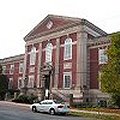- By Marcia E. Lynch
- News
 Print
Print  The County’s Independent Redistricting Commission, charged with preparing a plan for reapportioning County legislative districts, listened to comments from seven members of the County Legislature tonight regarding the size of the Legislature and other aspects of legislative districts, including those they represent.
The County’s Independent Redistricting Commission, charged with preparing a plan for reapportioning County legislative districts, listened to comments from seven members of the County Legislature tonight regarding the size of the Legislature and other aspects of legislative districts, including those they represent.As part of its charge from the Legislature, the Commission has been asked to advise on the size of the Legislature—which has stood at its current 15 members since 1974, but can range from 11 to 19 members under provisions of the County Charter.
Legislators who addressed the Commission tonight did not have a strong recommendation regarding the exact number of legislators needed, but many expressed concern that, a smaller Legislature could make it difficult to get the necessary work done and preserve quality representation. Lansing Legislator Pat Pryor (District 6) was one who noted that, with number of County departments, programs, and committee and advisory board assignments, “the size of the job we are asked to do is very, very large…How is the work going to get done if we decrease the size of the Legislature?”
Legislature Chair Martha Robertson (District 13) observed that a significantly smaller Legislature and increased workload might result in less Legislature oversight of County programs.
Legislator Mike Lane (District 13) said he would like the Commission to consider a smaller Legislature, that it could produce less pressure on very limited space and might also decrease cost. Speaking of legislators, Lane reminded the Commission, “We’re all expendable.”
Legislator Peter Stein (District 11) said an even number of legislators—such as 14—should not be considered a problem, since the Legislature could still require eight votes, as it currently does, to approve any action.
Many of the legislators said that commonality of interests, such as within neighborhoods, be considered in any redistricting plan, and Chair Robertson suggested that school district boundaries be considered as part of the mix if division along municipal lines alone does not achieve the population variance among districts of plus-or-minus 5% required by law.
The legislators who spoke were unanimous in urging the Commission not to consider a weighted voting scheme to address population discrepancies, such as is used in a number of Counties and was employed in Tompkins County following the 1980 Census. Several predicted such an approach would be “a disaster.”
Other members of the Legislature who were not able to attend tonight will have the opportunity to address the Commission at a later time. The Commission next month holds sessions on the eastern and western sides of the County, seeking input from municipal officials.
County Information Technology Services Director Greg Potter also reported to the Commission on his department’s further analysis of a significant loss of population in the City’s Fall Creek area in the 2010 Census, saying the shift appears to result from population shifts in group quarters (student housing) from that recorded a decade earlier.
v7i29



